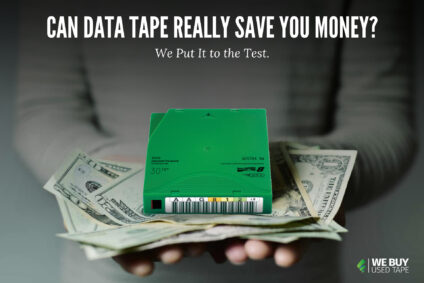Tape VS. Disk – The Great Data Battle


It’s a no brainer that every business relies upon data for success. Whether you own a retail operation that relies upon inventory databases or a car dealership that depends on a customer list, data storage is a necessity for every business. The way in which data is archived and backed-up can differ from company to company, based upon specific needs.
Before the emergence of cloud storage, the two most common forms of data storage were tape backup and hard drive or disk. What does each form of backup involve? What are the benefits and downsides of each? If you have reservations about which data backup strategy is best for your situation, you will find the solution you need below.
BASICS OF TAPE AND DISK BACKUP
The main difference between the two types of backup is the means onto which your data is stored. Tape backup delivers the ability to copy data from a hard drive to a tape cartridge for storage, backup, and recovery purposes in the event of a computer crash, ransomware attack, or natural disaster.
On the other hand, hard drive or disk backup involves copying data and other information onto a hard drive for easy access later on. Deciding between tape and disk backup can be tough, but it is important to realize the abilities of both.
TAPE BACKUP VS. DISK BACKUP
When comparing tape backup vs. disk backup, there are four significant factors to consider:
- Speed
- Capacity
- Cost
- Labor Intensity
SPEED
When it comes to speed, the common opinion among IT professionals is that disk backup holds the advantage over tape backup. In fact, disk storage systems backup much faster than tape because they have the ability execute data deduplication – which means they won’t copy data already stored on the backup. Furthermore, disk storage can be accessed much faster than tape. However, tape’s seek time improved greatly with the LTFS (linear tape file system) feature. LTFS lets you find data more easily, similar to disks. However, LTFS can’t make tape searches faster than disk.
CAPACITY
The rapid advance of tape storage technology has progressed beyond the abilities of disk backup. Today, tape backup can store up to 30TB on a single cartridge, much more than most single disk backup devices. This not only offers storage benefits, but usability and accessibility become simpler when everything can be stored in one place and off-site.
COST
Historically, tape has been approximately eight or ten times less expensive than disk storage to acquire and operate. Recently, vendors are touting improved disk backup systems that have closed the gap on tape in terms of cost per TB, but it’s still not even close. The total cost of ownership (TCO) of choosing the best backup solution can be represented by a simple equation. On one side is the business opportunity or revenue potential, and on the other side the cost of providing the data protection service. The cost of providing the service must be less than the business opportunity.
LABOR INTENSITY
Last but not least, you have to consider the amount of labor required to implement, operate, and maintain the data backup. With disk backup you must remember that it requires a 24/7/365 source of energy to continue operating. Tape does not. You use a tape only when transferring data to it. After that, it sits on a shelf. It remains offline, unplugged from potential cyberattacks.
WHICH IS THE BEST CHOICE?
Tape backup vs. disk backup, it’s not an easy choice to make. Tape backup makes more logical sense in terms of cost, storage capacity, speed, and usability. Ultimately, the decision lies with what your specific needs are as an organization. Do you need quick access, onsite storage? Or do you need long-lasting, secure, high-capacity archives? Only you can make that choice. Whatever your individual needs may be, we can help!





